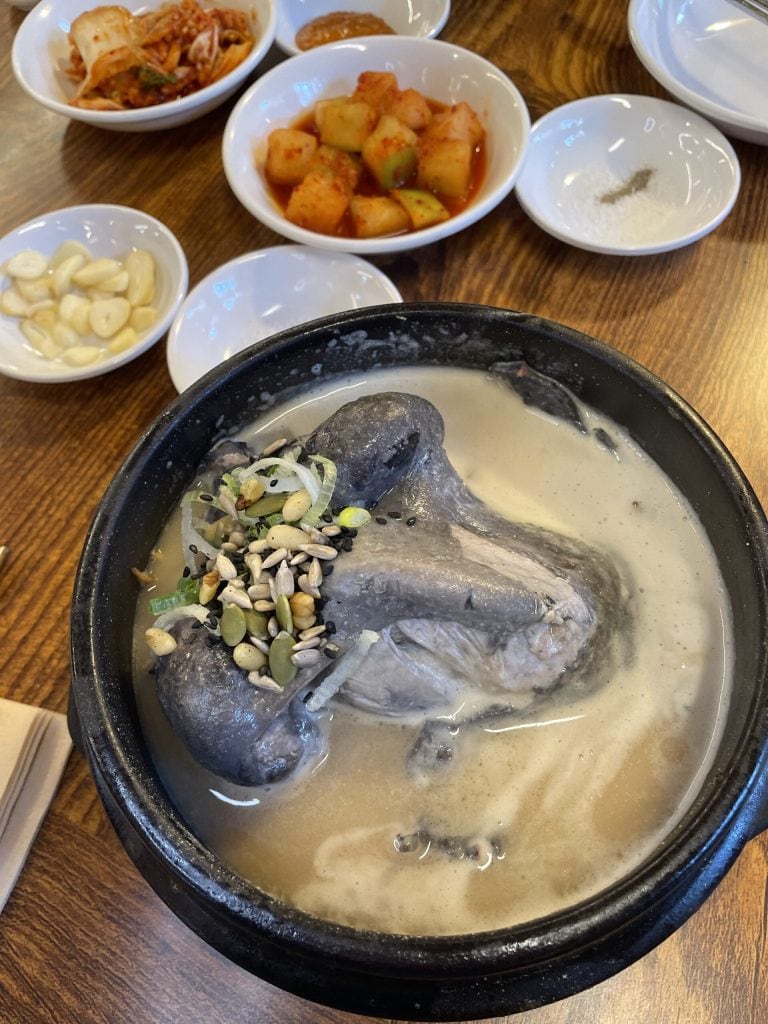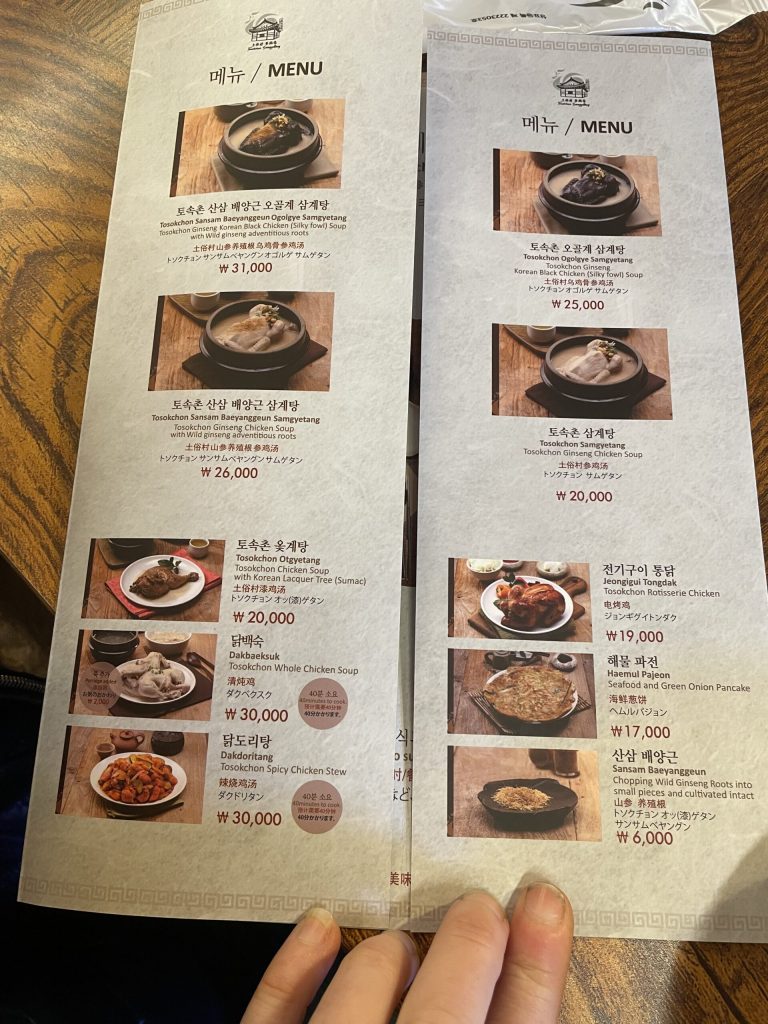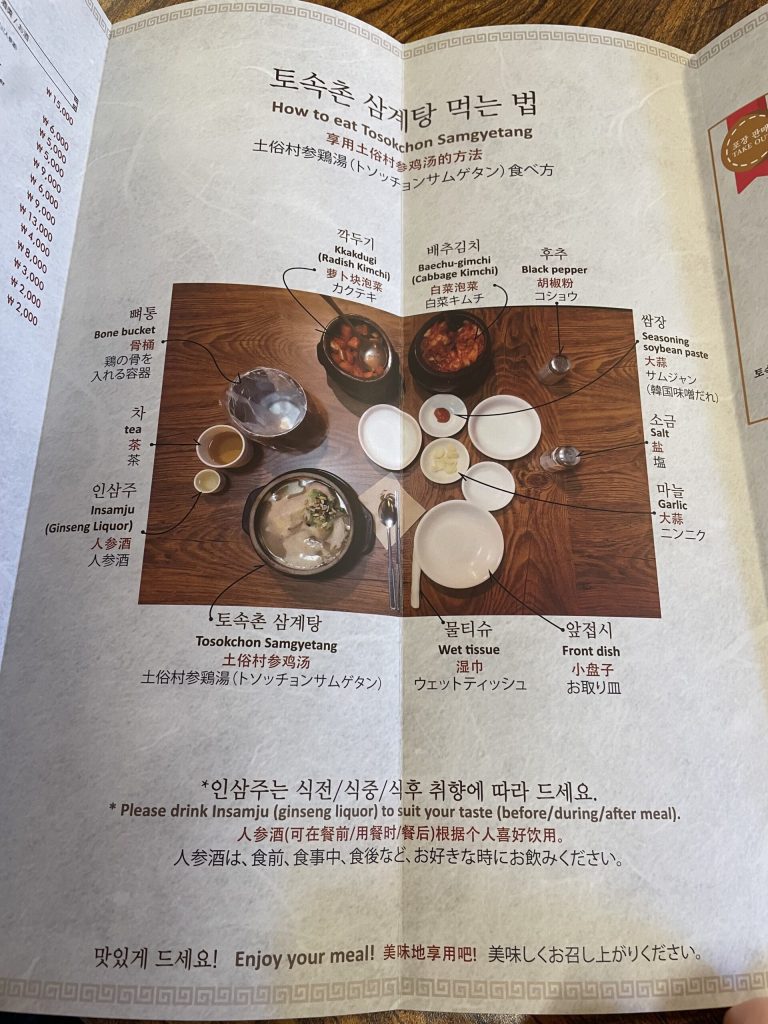Samgyetang is a popular traditional Korean soup, especially during the warmer months. It’s a hot ginseng chicken soup featuring a whole young chicken stuffed with glutinous rice, ginseng, garlic, and daechu (jujube).
Soup made with a slightly larger chicken is called Yeonggye Baeksuk, and chicken divided in half is called Banggye-tang.
It is particularly consumed during the hottest days of summer, like “chobok“, which marks the beginning of the summer season in Korea.
Tradition has it that eating this dish helps replenish energy and counter the fatigue caused by the summer heat.
Ginseng boosts metabolism and helps recover from fatigue, garlic acts as a tonic, while jujubes protect the stomach and prevent anemia.
Koreans have a saying: Yi yeol chi yeol, which means “fight fire with fire.” In other words… If it’s hot outside, beat it with a hot soup!
The dish began to be commercially sold in restaurants around 1940 and was called Gyesam-tang in the 1950s, meaning ginseng chicken soup. Later, to emphasize the medicinal effects of ginseng in the soup, the dish was renamed Samgye-tang: ginseng (sam) – chicken (gye) – soup (tang).
We tasted the specialty during our trip to Seoul in March 2025 at the famous “Tosokchon Samgyetang” restaurant. Usually, there are long lines outside to get in… we were lucky.

- Difficulty: Medium
- Cost: Inexpensive
- Rest time: 30 Minutes
- Preparation time: 10 Minutes
- Portions: 1 Person
- Cooking methods: Boiling
- Cuisine: Korean
- Seasonality: Summer, All Seasons
Ingredients
- 1 whole young chicken (600 g/800 g)
- 150 g glutinous rice
- 10 cloves garlic (whole)
- 1 ginseng root (or dried ginseng)
- 3 green onions (or shallots)
- 6 jujubes
- to taste salt and pepper
- to taste sunflower seeds (optional)
Steps
Prepare the chicken:
Clean the chicken well, removing the innards and any remaining feathers. Trim the neck area if present.
Rinse the chicken under cold running water.Soak the jujubes in warm water for about 20-30 minutes. If fresh, you can simply add them whole into the chicken cavity during preparation.
Prepare the rice:
Wash the glutinous rice in plenty of water until the water runs clear. Soak the rice for about 30 minutes (or even 1 hour, if possible).
Stuff the chicken:
Fill the chicken cavity with glutinous rice. Add jujubes, whole garlic, and ginseng root inside the chicken, along with a bit of black pepper.
You can also put some sesame oil inside the cavity for a richer flavor.
Cook the soup:
Place the stuffed chicken in a large enough pot, add about 1.5 liters of water (it should completely cover the chicken).
Bring to a boil over medium-high heat, then reduce to low heat and cook for about 1 hour and 30 minutes to 2 hours. During cooking, skim occasionally to remove impurities and get a clear broth.
Once cooked, remove the chicken from the pot and place it on a plate.
Serve the soup in individual bowls with some hot broth.
Garnish with chopped green onions and adjust with salt and black pepper.Sunflower seeds can be added on top of the soup just before serving as a garnish. They can be lightly toasted in a pan without oil to enhance the flavor, or you can use them raw for a more delicate effect.
While not a traditional Korean ingredient, adding sunflower seeds can be a way to add a touch of crunch.
Samgyetang is served hot, and traditionally, the chicken is eaten with hands.
This is the restaurant menu that offers only Samgyetang.
All chickens are the small Cornish Hen variety: white chicken, white chicken with extra dried ginseng roots for sprinkling (which enhances the aroma and beneficial properties of the soup), black chicken, and black chicken with extra dried ginseng roots for sprinkling.
Along with the meal, tea is offered, the inevitable Korean side dishes, and even a shot of ginseng liquor, which can be purchased within the restaurant.
Inside the menu, there is also a guide on how to eat Samgyetang.


FAQ (Frequently Asked Questions)
What are the “hot days” in Korea?
Koreans designate the 3 hottest days of the year as sambok, and the dates vary from year to year, but they usually fall in July and August.
The first is chobok (beginning), then 10 days later is jungbok (middle), and 20 days later is malbok (last).

